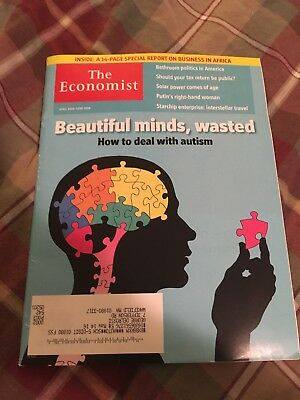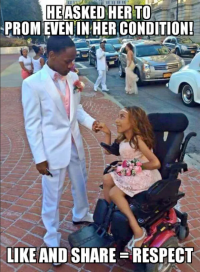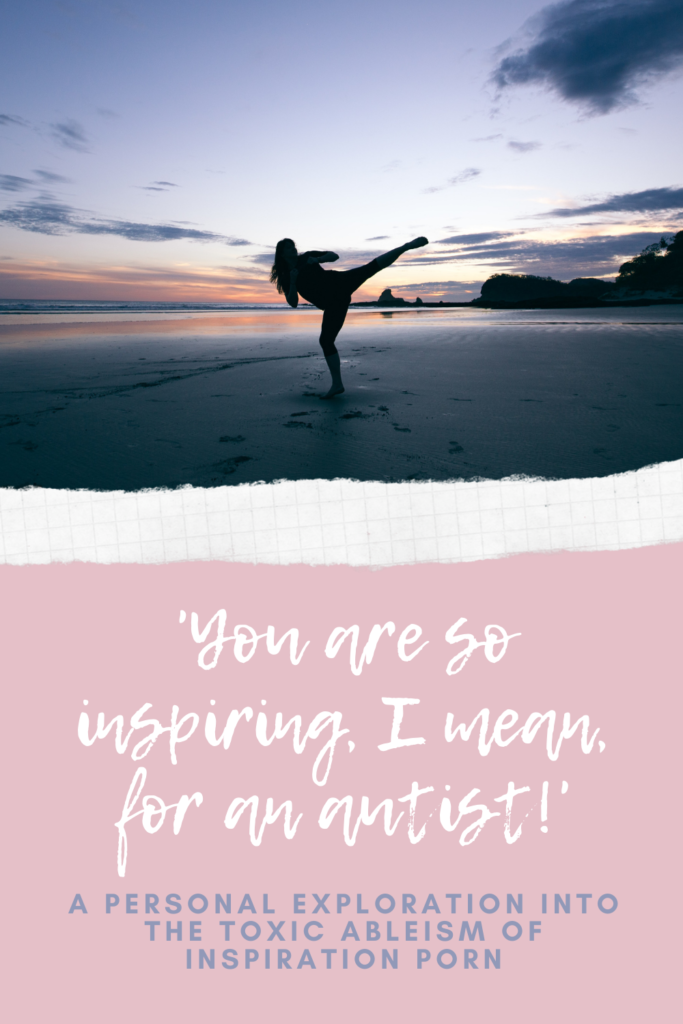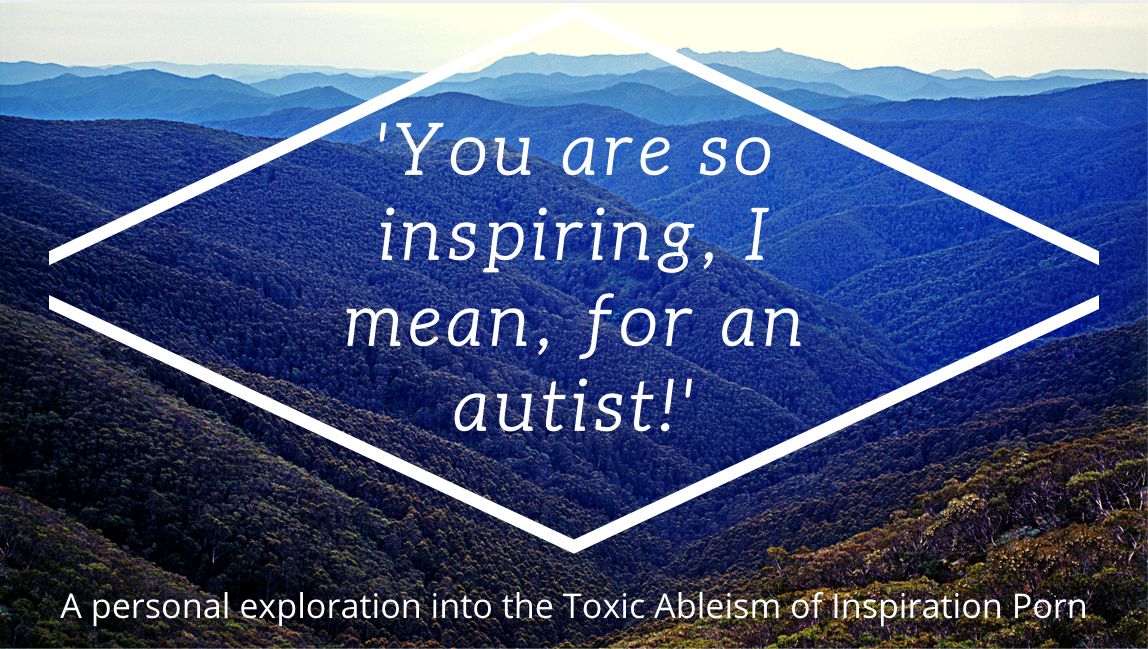A personal exploration into the Toxic Ableism of Inspiration Porn, originally written for feminist magazine Lover.
When I published my autiethnography “The Do less travelled by” (about the benefits and challenges of budo for people on the autism spectrum), I was overwhelmed by the reactions. Hundreds of people reached out to me. Most of the feedback I received made me very happy, as it was about my hard work and the skills I developed. Some of it was mean and ignorant, stating that autism is “not a real handicap” or “I hope that they’ll find a cure” (it’s not an illness, people). And some of it confused me, as I felt that these comments framed me as being less than human.
Disguised as praise, the reactions in the latter category often came in the form of a two-layered comment. Like, “You are so brave, that you dare to admit that you are autistic.” And: “Wow, it is so great that your teammates will train with you!”. Or: “You are such an inspiration, for if you as an autist can win a prize, well, then there is so much possible for the rest of us, haha”. No doubt these people meant well, but the comments wouldn’t leave me alone and I didn’t understand why they made me feel so humiliated.
I did what I always do when I do not understand something: I googled. And I learnt that, during the last decade, there has been a significant increase in visibility of people with disabilities in mainstream media. This is a positive development, as increasing the general knowledge about a certain group of people will likely lessen prejudices against this group. However, with growth of representation, comes misrepresentation as well. The strange (but likely well-meant) compliments I received fit in with a problematic new trend in the history of oppression experienced by people with disabilities, called ‘Inspiration Porn’.
Inspiration Porn
When Stella Young (2012) first coined this term, Inspiration Porn referred to people with disabilities performing ordinary tasks as a form of inspiration to able neurotypicals. Since then, its meaning has broadened. As Annie Elainey (2016) explains, “Inspiration Porn refers to any narrative where a disabled person is spoken or written about as ‘inspiring’ merely because of their disability, as well as narratives where a disabled person’s autonomy is not respected or their dignity stripped away, and, as well as narratives where able and neurotypical folks are praised for merely being decent to a disabled person.” Similar to the White Saviour Complex, it places able bodied (and neurotypical) people on the highest tier in the societal pyramid and disabled people on the lowest. As if they need to be either pitied or saved.
In the discourse of Inspiration Porn, people often avoid the word ‘disabled’ and use ‘differently abled’ instead. The assumption of which, however well-intentioned, feels paternalistic. As if calling people ‘disabled’ denigrates the disabled person, and one cannot name the limitations of people with disabilities. This provides a false and harmful interpretation of disability as if there were no disability, despite everyone having their own limitations. Society is geared to the greatest common denominators: to what most people can hear (within margins of decibels and frequencies), see (idem, within distances and spectra) and reach (by walking, standing and touch). Whether someone is disabled depends on the environment – as my friend Tim once so aptly put it: “If our society was designed to do everything flying, all people would be disabled.” Context is everything. As Jessica Kellgren-Fozard states: “I was a square peg and there were only round holes”. Personally, I often feel like a Linux machine in a world of Windows and Macs. Does that make me disabled or does society disable me?
Ableism
The ableist idea of disability as a shameful burden is rooted in (if not based on) the historical medical model of disabilities. In this model, disability is seen as an obstacle that you can overcome, to reach a higher quality of life, if only you try hard enough. This narrative is so common, that it has become a media trope: Inspirationally Disadvantaged. From personal experience, I can testify to the harmfulness of that assumption. All my life I tried to fit in with society and pass as a “normal” human being. It always felt as if I could do it, with just a little more effort and if I just tried a little harder.
Sadly, harmful ableist ideas like these continue to be reinforced in society, accompanied by unfavourable stereotypes, which seriously hurt the development, feelings and acceptance of people with all types of disabilities. Unfortunately, ableism is not limited to abled people. Wheelchair fencer Elke Lale van Achterberg is an athlete I greatly admire, but even she has posts on her social media like “Just know that nothing is impossible as long as you fight for it!!!”. Not true, unfortunately. I could work my ass off everyday, but due to my slow processing of stimuli, I will never be as fast as she is. Of course, she puts in a lot of hard work, which is to her credit, but it can also be partially credited to the ‘Inspirationally Disadvantaged’ media trope that Elke is so successful as a media personality. Whether it is on purpose to manipulate the media, or internalized ableism (both of which are rather sad), it plays into the stereotypes that we are familiar with. In her hilarious and thoughtful analysis, Jessica Kellgren-Fozard points out that there are only two types of disability in Hollywood movies -“the angels, like The Boy Who Could Fly” and “the evil cripple like Doctor Strangelove”. She wonders why so many Oscars are won by able people pretending to be disabled, when will disabled people be allowed to represent themselves?
The ways disabled people are portrayed range from problematic to plain rude. Take for example, this magazine cover of the well-known and respected publication The Economist, headlining: “Beautiful minds, wasted – how to deal with autism”. These are horrible words. The mind of an autistic person is not “wasted” – wasted for what? And there is nothing “to deal with” as autism is not a burden. This is offensive and it hurts. How would the writer feel themself when I would state that their mind is wasted and suggest some tips for the world around them to deal with this? No shit, I – as an autistic person – am probably more self-aware than the person who wrote this! So please, do not write about people with autism without consulting people with autism – it’s not that hard. Next to the absurd title and subtitle, the image of a puzzle brain with a missing piece is totally out of place as well. The idea of puzzle pieces to signify autism was invented by the National Autistic Society. It symbolizes that people with autism are “handicapped by a puzzling condition” which “isolates them from normal human contact”. Moreover, they stress that this logo stands for hope. All of this is a gross insult and freakin’ annoying – I am not a puzzle for you to solve or fix, and I do not hope for a cure to overcome my disability.

Another pinnacle of ableism is Inspiration Porn. The image below is a good example: an image of a guy in a wheelchair, kissing a beautiful woman, with the text: “How could a guy ever say “forever alone” after looking at this picture? Come on guys. If he can get this pretty girl, you can do it too!” Sadly, there are tons of images like this one, of people with visible physical disabilities and captions such as “The only disability in life is a bad attitude” or “Your excuse ?is invalid”. As Stella Young explained, the sole purpose of these memes is “that non-disabled people can put their worries into perspective… It’s there so that non-disabled people can look at us and think ‘Well, it could be worse… I could be that person!’” Quite apart from the facts that a) we know nothing about the people in the photograph so comparing makes little sense and b) that these people probably did not give permission for this use of their photograph.

Toxic ableism
Ableism was hidden in the comments I received, keeps popping up in mainstream media and is clearly visible in Inspiration Porn memes. While it appears to highlight the positive sides of life and people with disabilities, Inspiration Porn is actually very problematic. It reinforces the idea that people who have disabilities are somehow of less value and less capable than able-bodied and neurotypical people. Be critical, would the same story or meme be as inspiring if the central character was not disabled? This is toxic because of three reasons:
1. First of all, within the construct of society’s institutions by and for the typically abled, a person with a disability is explicitly framed as the Other, distancing people with disabilities from individuals who are not disabled. Inspiration Porn dehumanizes and objectifies persons with disabilities for the benefits of the typically abled, who can then feel better about themselves. This is embarrassing, infantilizing and demoralizing. Moreover, it praises disabled people for the wrong reasons.
2. Secondly, Inspiration Porn portrays disability as an obstacle – a negative thing – to overcome, deal with or rehabilitate from. This is also known as ‘supercrip’, a term used in disability communities and academia, describing the stereotypical representation of people with disabilities as heroically overcoming their disabilities. This is degrading to the disabled community because it implies that however bad the lives of abled people are (e.g. due to lack of finances), they could always be worse (at least they are not disabled).
3. Thirdly, it also spreads harmful ideas in the disabilities community. Like the ‘Inspirationally Disadvantaged’ media trope, disabled people could accomplish whatever they desire if they’d only try hard enough and do not give up. Meaning that if a person with a disability cannot do something, it is because they lack motivation and fighting spirit.
The future is ours
Luckily, many modern thinkers reject these ableist ideas. Robert McRuer states that disability is a viable identity that should be acknowledged and accepted by society at large. But that is difficult, as, according to Sunaura Taylor, human society as a whole is guilty of ableism. Like animals, disabled people are mistreated with little or no moral guilt. They are discriminated against and misused as objects for inspiration or ridicule. As Lover editor Maaike explained: “If a pet just walks, or eats, or sits down, we are all like ‘aaawwhhhh omg look how cute!!!’ while that animal doesn’t actually do anything… it just lives its life.” But the same extreme reaction is given when an animal does something that people do not approve of. The cute kitten is no longer a well-behaved pet, instead it becomes Magret Shildrick’s definition of a ‘monster’ (2002). Someone or something that is not appropriated and does not fit in with our idea of well-behaved society. This is supported by Alison Kafer’s definition of the monster (2013), as one who moves away from human normative limits
Rosemarie Garland-Thomson (2017) explores what it means to be such a monster and provides the necessary changes, like “equal access to a democratic public sphere […] such as the workplace, marketplace, media, transportation facilities, and public institutions such as schools, health-care centers, archives, and governmental spaces” (2011:601). These changes are social, not personal, and are too often overlooked by the ableist society that merely focuses on using people with disabilities to feel better about themselves. We must think critically when reading a social media post that pictures an able person as a hero just for being nice to a disabled person – like the meme below – awareness is the first step towards change. As Katie Rose Guest Pryal states: “We can’t get away from ableist memes and magazine covers. But we don’t have to accept them.” Nowadays, if disabled people are not motivational, they are monstrous, and that makes other people uncomfortable. But it is not as if we exist so abled people can feel better. We also have a right to fail, to be bummed out, to complain.

For disabled people, this is deeply important and existential. It is about our lives being valued as less worthy than the lives of able and neurotypical people. For example: because our society is not designed and / or inclusive to me and my needs, I cannot work as much as I would like. That’s why I receive welfare, but I have been made to feel like instead of complaining about my situation, I should be thankful. This is pointless, useless, unnecessary. It only leads to what Carolanne Link describes as “the constant struggle between burden and entitlement” – on the one hand, I fear being a burden on my loved ones, on the other, I feel entitled to a minimum income. Apart from the fact that my benefit is much less than the minimum wage, it’s just not right that I should be happy and grateful all the time, while others can complain about their salaries. And come on… first of all I can’t participate and then I get even less money to spend? Not fair.
Inspiration Porn can’t hide the key issues of disability politics by painting the people with disabilities as cardboard figures in a sunny play. Of course, you can be inspired by a person with a disability, just as long as it is based on their attitude, actions and achievements. As disabled YouTuber Molly Burke puts it – “in an empowering way“. But when the inspiration is solely drawn from the fact that a certain person has some sort of disability, it is an expression of the toxic ableism called inspiration porn. And in the words of Annie Elainey, that is “objectifying and dehumanizing to disabled people“. Therefore, with a bit of delay, I would like to answer the confusing (well-meant but harmful) comments I received: I would be honoured if my hard work inspired you. I treasure my prizes not only as a celebration of my success but – more importantly – as a celebration of the road to that success. For, at the end of the day, my disability is nothing more than my version of normal. What’s yours?

References
Burke, M. (2017). Inspiration porn? https://youtu.be/o1kbJxVPBAU
Elainey, A. (2016). What is Inspiration Porn? https://youtu.be/YmGtGaXbJSQ
Garland-Thomson, R. (2011). Misfits: A feminist materialist disability
concept. Hypatia 26(3): 591–609.
Garland-Thomson, R. (2017). Extraordinary bodies: Figuring physical disability in
American culture and literature. Columbia University Press.
Kafer, A. (2013). Feminist, Queer, Crip. Bloomington; Indiana University Press, 103-128.
Kellgren-Fozard, J. (2020). Inspiration P*rn: Oscar Bait!
https://youtu.be/WxefTlluqMM
Link, C. (2020). Burden vs. Entitlement: A Disabled Person’s Internal Battle. ULCA. https://dcp.ucla.edu/node/88
McRuer, R. (2006). Crip theory: Cultural signs of queerness and disability. NYU press.
Mussies, M. (2020). The do less travelled by (on autism and martial arts). Zanshin.
Pryal, K. R. G. (2018). The Inescapable Images of Ableism. Medium.
Shildrick, M. (2002). Embodying the monster: Encounters With the Vulnerable Self.
London: Sage Publications.
Taylor, S. (2011). Beasts of burden: Disability studies and animal rights. Qui Parle:
Critical Humanities and Social Sciences, 19(2), 191-222.
Young, S. (2012). We’re not here for your inspiration – The Drum (Australian
Broadcasting Corporation). Abc.net.au.
.
